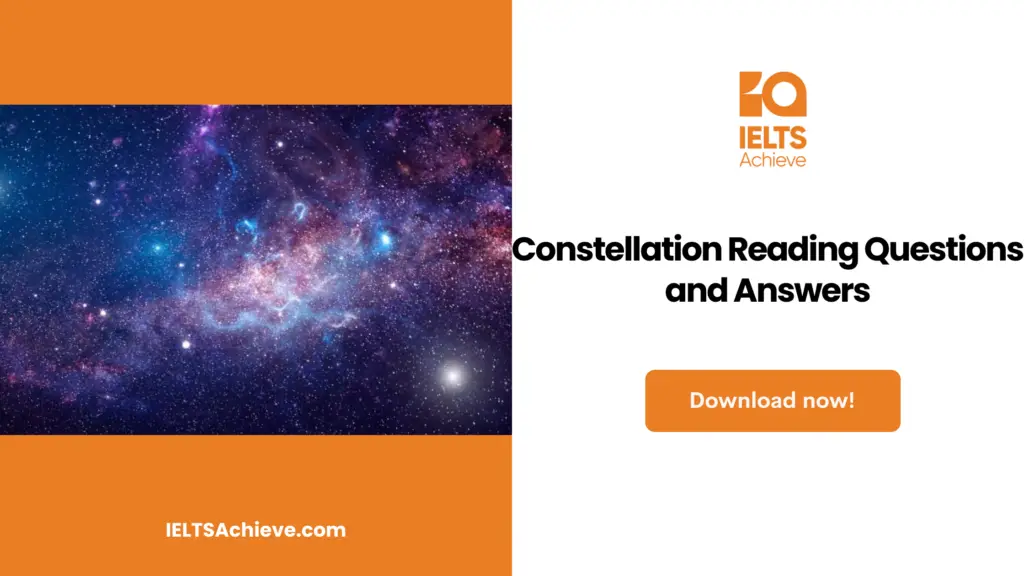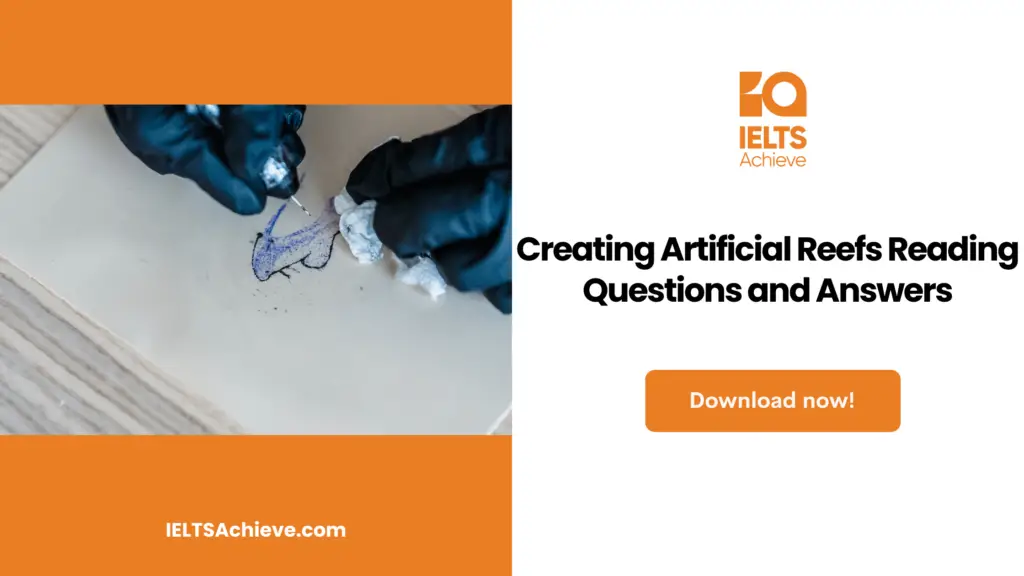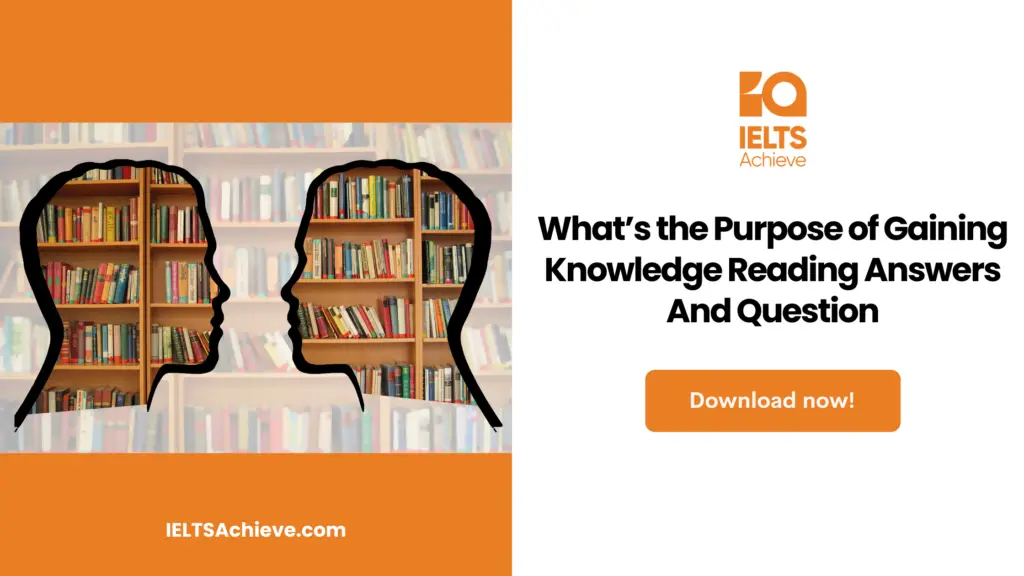The Blog post contains the following IELTS Reading Questions:
- IELTS Reading Matching Headings
- IELTS Reading Summary Completion
Stay informed and prepared for success – Explore our comprehensive Reading Test Info page to get valuable insights, exam format details, and expert tips for mastering the IELTS Reading section.
IELTS Reading passage – Constellation

Constellation
A. A constellation is a group of stars which when viewed collectively appear to have a physical proximity in the sky. Constellation boundaries and definitions as used today in Western culture, and as defined by the International Astronomical Union (IAU), were formalised in 1930 by Eugene Delporte. There are 88 official constellations as recognised by the IAU, those visible in the northern hemisphere being based upon those established by the ancient Greeks, The constellations of the southern hemisphere – since invisible to the Greeks due to geographical location – were not defined until later in the early modern era.
B. Arguably, the twelve constellations through which the sun passes – as used to represent the signs of the zodiac to define birth characteristics – are the most culturally significant and well known of those established by the ancient Greeks. Cultural differences in Interpretation and definition of star constellations mainly relate to these zodiac interpretations, Chinese constellations, for example, which are different to those defined in the western world due to the independent development of ancient Chinese astronomy, includes 28 ‘Xiu’ or ‘mansions’ instead of the 12 western zodiac counterparts. In Hindu/Vedic astronomy, in which constellations are known as ‘rashis’, 12 rashi corresponding directly to the twelve western star signs are acknowledged; these are however, divided again into 27 ‘Nakshatras’ or ’lunar houses’. Many cultures have an intricate mythology behind the stars and their constellations. In Greek mythology, for example Pegasus, the winged horse, is said to have sprung from the decapitated head of Medusa, and later was used by the God King Zeus to carry thunder and lightning to Earth, before being put into a constellation.
C. In Western astronomy, all modern constellation names derive from Latin, some stars within the constellations are named using the genitive form of the Latin word by using the usual rules of Latin grammar. For example the zodiac sign for the Fish constellation Pisces relates to Piscium. In addition, all constellation names have a standard three-letter abbreviation as assigned by the IAU, under which, for example, Pisces becomes PSC.
D. Some star patterns often wrongly considered constellations by laymen are actually ‘asterisms’ – a group of stars that appear to form patterns in the sky -and are not in fact one of the 88 officially divided areas truly defined as a constellation. A famous example of an asterism oft mistaken for a constellation is the Big Dipper’ (as it is termed in North America) or the ‘Plough’ as it is known in the UK. In astronomical terms, this famous star formation is in fact considered only part of the larger constellation known as Ursa Major.
E. In order to identify the position of stars relative to the Earth, there are a number of different celestial coordinate systems that cart provide a detailed reference point in space. There are many different systems, all of which are largely similar with the exception of a difference in the position of the fundamental plane – the division between northern and southern hemispheres. The five most common celestial systems are the Horizontal system, the Equatorial system, the Ecliptical system, the Galactic system and the Supergalactic system.
F. The launch of the Hubble space telescope in April 1990 changed the way that astronomers saw the universe, providing detailed digital images of constellations, planets and gas- clouds that had never been seen before. Compared to ground-based telescopes, Hubble is not particularly large. With a primary mirror diameter of 2.4 meters (94.5 inches). Hubble would be considered a medium-size telescope on the ground. However, the combination of its precision optics, state-of-the-art instrumentation, and unprecedented pointing stability and control, allows Hubble to more than make up for its lack of size, giving it a range of well over 12 billion light years.
G. The telescope’s location above the Earth’s atmosphere also has a number of significant advantages over land based telescopes. The atmosphere bends light due to a phenomenon known as diffraction (this is what causes starlight to appear to twinkle and leads to the often blurred images seen through ground-based telescopes). The Hubble Space Telescope can also observe infrared light that would otherwise be blocked by the atmosphere as the wavelength (distance between successive wave crests) of ultraviolet light is shorter than that of visible light.
H. Despite early setbacks – one of the reflective mirrors had to be replaced after finding that it had been ground incorrectly and did not produce the images expected – the telescope has reignited interest in space amongst the general public – a requirement, given that taxpayer funding paid for the research, deployment and maintenance of the telescope.
Unlock your full potential in the IELTS Reading section – Visit our IELTS Reading Practice Question Answer page now!
Recommended Questions:
Renewable Energy IELTS Reading Question with Answer
Questions 1 – 8
Reading Passage 1 has eight paragraphs A-H. Choose the correct heading for paragraphs A-H from the list of headings below. Write the correct number i-xii in boxes 1-8.
List of Headings
i. Different methods of locating and identifying
ii. A better view of the constellations
iii. Technological advances in research and development
iv. Atmospheric weaknesses of telescopes in orbit
v. Different interpretations of star groupings
vi. Common misconceptions
vii. Bypassing terrestrial limitations
viii. Renewed interest in the stars
ix. Ethnic differences in celestial mapping
x. Formal marking of constellations
xi. Universal myths of constellations
xii. Historical and modern reference
1) Paragraph A
2) Paragraph B
3) Paragraph C
4) Paragraph D
5) Paragraph E
6) Paragraph F
7) Paragraph G
8) Paragraph H
Ready to conquer Matching Headings questions? Click here to learn essential tips and techniques for matching headings accurately to paragraphs or sections in the IELTS Reading section.
Questions 9 – 13
Complete the summary below using NO MORE THAN TWO WORDS. Write the correct answers in boxes 9-13.
Despite an initial flaw in a 9) _______________, the Hubble space telescope is superior to telescopes on land as it can identify 10) _________________ which would not normally reach the Earth’s surface. This is all the more impressive given that Hubble is only classified as a 11) _______________ telescope. Being above the atmosphere, it also has the advantages of not being affected by 12) _____________, which would otherwise lead to 13) ______________ images.
Boost your performance in Summary, Notes, Table, and Flowchart Completion tasks. Click here to explore our detailed guide and learn how to effectively complete summaries, notes, tables, and flowcharts in the IELTS Reading section.
Unlock your full potential in the IELTS Reading section – Visit our IELTS Reading Practice Question Answer page now!
Recommended Questions:
Renewable Energy IELTS Reading Question with Answer
Answers
1) X
2) V
3) XII
4) VI
5) I
6) II
7) VII
8) VIII
9) (reflective) mirror
10) Infrared light
11) Medium sized
12) Diffraction
13) Blurred

We hope you found this post useful in helping you to study for the IELTS Test. If you have any questions please let us know in the comments below or on the Facebook page.
The best way to keep up to date with posts like this is to like us on Facebook, then follow us on Instagram and Pinterest. If you need help preparing for the IELTS Test, join the IELTS Achieve Academy and see how we can assist you to achieve your desired band score. We offer an essay correction service, mock exams and online courses.

